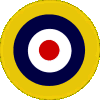The Distinguishing Characteristics of Battle of Britain Pilots and Aircrew
MEDAL RIBBON WITH ROSETTE
The medal ribbon displayed is the 1939-45 Star for service in operations. To distinguish all aircrew personnel who took part in the Battle of Britain between July 10th and October 31st 1940, a gilt rose emblem was awarded for wearing on the full size ribbon. On the miniature medal ribbon, worn on evening dress, a small bar was worn bearing the words "Battle of Britain"
The colours of dark blue, red and light blue on the 1939-45 ribbon represent the traditional colours of the Royal and Merchant Navies, the Army and the Royal Air Force.
On certain awards, a silver rosette indicates a further similar distinction or bar (i.e. D.S.O., D.S.C., M.C., D.F.C., A.F.C.) or the award of an alternative medal (i.e. Atlantic Star, Aircrew Europe or France and Germany Star; or Pacific Star and Burma Star) but the introduction of a Gold Rose is unique in the long history of all British Military Decorations and Medals.
THE BATTLE OF BRITAIN TIE
This tie was designed for the Battle of Britain Fighter Association by Mr. Herbert-Jones. It is a silk tie with the designs of the United Kingdom and Gold Rosette woven in gold. It is one of the most coveted ties in existence and is worn exclusively by the surviving Battle of Britain Pilots and Aircrew.
QUALIFYING CONDITIONS
To qualify for the distinction of being a Battle of Britain Pilot or Aircrew, the applicant must have flown at least one operational sortie in an accredited Battle of Britain squadron, flight or unit (see authentic list) during the Battle of Britain period, i.e. between July 10th and October 31st 1940.

